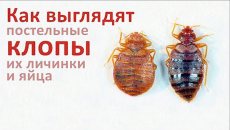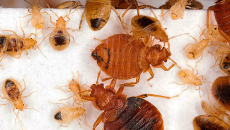During the experiment, we treated the plastic container with Hangman. A week later, bedbugs were placed in a container - they all died after 20 hours and 27 minutes from the start of the test. The result obtained clearly showed that the Executioner retains a residual effect on the treated surfaces for a long time.
Watch video:
0:10 - In the experiment, let's see how the Executioner will destroy the bugs when they come into contact with the surface, which was treated with the agent a week ago.
0:43 - Why is it so important to find out if the product is able to maintain high efficiency for a long time after drying? The fact is that if the Executioner really retains its activity a week after drying, then it will effectively destroy the bug larvae, which are gradually hatched from the eggs (and the eggs can be located anywhere in the apartment). That is, due to the long residual action, it would be possible to do without re-treatment of the apartment.
1:25 - Also, it's useful to have a rough idea of how long the Executioner is able to provide a protective effect against bed bugs, which from time to time enter the apartment from neighbors.
1:48 - The manufacturer states that the residual effect of the product lasts 1-2 weeks. Now we will check whether this is actually the case.
1:58 - We prepare a working solution: we dissolve three bottles of the product in 1 liter of tap water.
2:25 - The concentrate in vials has a specific smell, and the prepared solution also smells. After the solution dries and the room is ventilated, the smell disappears, so there is no smell left in the apartment after its treatment and ventilation.
2:59 - Pour the prepared solution into a regular household spray bottle.
3:39 - We take a plastic container and carefully spray it with the previously prepared working solution. Leave the container to dry open for 7 days.
4:15 - A week has passed since the container was processed. There were no traces of the product left on its bottom. Accordingly, it can be assumed that there will be no stains and other marks on other surfaces - on wallpaper, upholstered furniture, the floor (that is, in the apartment after processing).
4:32 - We place the tested bugs in the container. In total, 5 individuals were taken for testing: 4 adults and one nymph.
5:37 - We mark the time. Let's see when the bugs show the first signs of poisoning and when they die.
5:46 - Useful information about the mechanism of action of the Executioner in the destruction of insects. We present previously obtained data on the rate of death of cockroaches and bedbugs during direct treatment with a solution and in contact with a recently dried agent.
6:29 - There is an assumption that the more time has passed after surface treatment with a solution, the worse the product will work due to possible weathering and decomposition of the active substance (in the composition of the Executioner it is the insecticide fenthion). We will test this assumption in the course of the experiment.
6:48 - Half an hour after placing the bedbugs in a plastic container, they are all still alive.
7:22 - 1 hour has passed since the bed bugs were placed in the container. All individuals are alive.
7:44 – 2.5 hours have passed.One bug is already paralyzed, but still alive. The rest are showing normal activity.
8:22 - After 3 hours from the start of the test, the situation has not changed much - one bug is barely alive, the rest are active.
8:58 - After 5.5 hours from the start of the experiment, another bug is paralyzed. Three individuals still retain normal activity.
9:28 - 16 hours after placing the bugs in the container (the very next day), the situation is as follows: two parasites died and no longer move, three more individuals are clearly poisoned, partially paralyzed, but still alive.
10:08 - After 17 hours from the start of the test, the situation remains unchanged.
10:42 - 20 hours and 20 minutes have passed since the start of the experiment. All adults in the container died, but the nymph is still alive.
11:30 - After 20 hours 27 minutes from the moment of the first contact of the bugs with the Executioner, which had dried up a week ago, all the test individuals died.
12:19 – We conclude: all bed bugs died after 20 hours and 27 minutes from the moment of the first contact with the surface treated with the Executioner a week ago. At the same time, we recall that 1 hour after drying on the surface, the agent kills bedbugs in 19 hours (these data were obtained by us in the previous experiment). Thus, after 1 week, the insecticidal activity of the agent on the treated surface practically did not decrease.
12:50 - The container processed by the Executioner stood open all week, it was exposed to light. In other words, the fenthion insecticide here was subjected to approximately the same effects as it would be exposed to in an ordinary apartment, being on the floor, furniture or walls. And therefore, when used in a residential area, the substance will also retain its high efficiency.
13:11 - The result obtained suggests that, for at least a week, the dried Executioner will actively destroy both those parasites that could survive after processing, and the larvae that have just hatched from the eggs, and those individuals that can climb to the apartment from the neighbors after the bullying.
13:49 - Explanation of when it is appropriate to re-treat the premises with the Executioner.
On a note
After treating the apartment with a product, you should not wash it off from those surfaces with which you do not have to come into contact during life in the room - for example, under beds, from walls behind furniture, from the surface of skirting boards. The insecticide, which is dry on treated surfaces, is safe for humans and pets, but continues to work actively, finishing off the population of bedbugs in the room.
Comments and reviews:
There are 1 comments to the entry "We planted bedbugs in a container that was treated with the Executioner a week ago - we are looking to see if the parasites are poisoned by a long-dried agent ..." there is 1 comment











Hello. What to do if you treated the room (apartment) with the Executioner, left it for 2 days without ventilation, and on the 3rd day the bugs appeared again. Do I need to change the medium then?